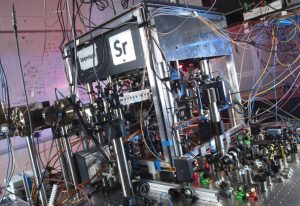“Reaching this milestone represents a significant achievement for the team and stems from a huge effort from many people over many years,” said NPL head of time Professor Helen Margolis. “I am delighted that we are now able to use our strontium optical lattice clock to contribute to global timekeeping.”
The best optical atomic clocks are ~100 times more precise than the best caesium atomic clocks.
TIA calculated monthly by the International Bureau of Weights and Measures (BIPM) by taking a weighted average of over 400 atomic clocks from ~80 metrology laboratories worldwide. “Most are caesium microwave standards, but recent years have seen optical standards contributing more and more,” said NPL.
UTC [coordinated universal time] is determined, in part, by TIA.
“NPL-Sr1 and its capacity to measure the accuracy of UTC provide an added value to the entire UTC community,” said BIPM director of time Patrizia Tavella. “The NPL Sr1 measurement has been taken into account by the BIPM in the most recent UTC computations, together with all the other standards including the NPL-CsF2 cesium fountain. The measurements are allowing a relative accuracy of UTC at the level of two parts in 1016 which means a possible error of half a nanosecond over one month.”
To join TIA, NPL compared NPL-Sr1 with the UK’s own physical UTC reference, and submitted findings to the Consultative for Time and Frequency working group of the BIPM’s International Committee for Weights and Measures (CIPM, Comité international des poids et mesures) which assessed the data and accepted the optical clock as a contributor to TAI.
“The next steps are to make data submissions which enable NPL-Sr1 to have a greater significance in steering TAI.,” said NPL. “The first of these was made at the end of April, in which NPL-Sr1 was the third highest contributor – at 9.63% – of the 14 primary and secondary frequency standards that contributed that month.”
Regular contribution of optical secondary frequency standards to TAI is mandatory for the mooted redefinition of the SI second, scheduled for 2030.
“We now join a select group of optical clocks from around the world that have a say on TAI, and support the transition to a possible new SI second,” said NPL optical lattice clock project leader Ian Hill.
Optical lattice clock?
Although referred to as ‘optical clocks’, these are also atomic clocks, but working at optical frequencies rather than the microwave frequencies that older atomic clocks work at.
In the NPL case, the active strontium atoms (not ions) are held in a grid-like lattice, with interfering laser beams constraing the regular pattern. Having thousands of atoms trapped simultaneously increases signal-to-noise ratio compared with clocks relying on fewer atoms.
Based in Teddington UK, NPL is one of the world’s leading reference laboratories.

